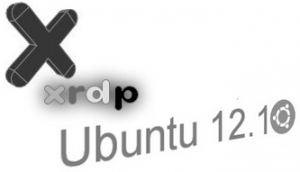
Hello World,
I’ve been asked by some people to explain how to configure xRDP in ubuntu 12.10 in order to be able to perform remote desktop connection into it. If you follow us for some time now, you know that we have covered this topic already multiple times. If you have
- ubuntu 10.xx, you can follow these instructions
- ubuntu 12.04, you can follow these instructions
Up to Ubuntu 12.04, it was possible to “easily” perform a remote desktop from a Windows machine and still being able to have a working Unity desktop interface. The workaround was to use the Ubuntu 2D desktop interface. Ubuntu 2D was the fallback solution for users with no 3D graphic card installed on their computer.
Because Ubuntu has drastically re-architect their Desktop interface (i.e. Unity) in 12.10, the Unity interface will not be available anymore through the remote desktop. In Ubuntu 12.10, the ubuntu 2D desktop interface does not exists anymore. With the latest version of Ubuntu, everybody is using the same Unity interface even if your computer does not have a 3D capable graphic card. Unity will be using hardware acceleration settings in order to display your Unity desktop interface.
This little change introduces limitations in the way you can use xRDP with Ubuntu 12.10. You will still be able to use xrpd solution in ubuntu 12.10 but you will need to configure the software in a way to use another fallback desktop interface (gnome-fallback). XRDP software cannot work with the Unity interface.
If you still need to perform rdp connection to your ubuntu machine, keep reading as we will explain how to do this…..
Install and Configure xrdp for Ubuntu 12.10
Step 1 – Download and install the xrdp package
Normally, you would open your Ubuntu Software Center and you would look for the xrdp package. In my case, the package was not available by default.
Click on picture for better resolution
So, I had to google for the package and landed up on the following web page where the package software can be installed. In this page, click on the button APT Install
Click on picture for better resolution
The Launch application dialog box will open. Ensure that the Ubuntu Software center is selected and Press OK
The Ubuntu Center software should be opening and you should now be able to perform the installation.
Press The install button. You will be prompted for credentials in order to perform the installation
When the installation is done. You should already be able to perform a remote desktop connection to your Ubuntu Machine. However, you will see only a empty desktop (as described in this post)
Step 2 – Configuring xRDP in order to have access to a Desktop Interface
In our scenario, the gnome fallback desktop interface will be the Unity replacement. So, in the Ubuntu Software Center, we will first instal the gnome fallback desktop. In Ubuntu Center Software, search for Gnome fallback and you should see the pakages. click on it, click on the install button and you should be good to go.
Step 3 – Configuring xRDP to use gnome fallback desktop
Finally, you need to tell xrdp software to use the gnome fallback desktop. To configure this, you will simply go to your home folder, ensure that the hidden files are visible (press Ctrl+H to view hidden files). In this directory, you will create a file called .xsession
Edit the file and enter the following textgnome-session --session=gnome-fallback
You should restart the service ( from a command line sudo service xrdp restart) or simply restart the computer to have the changes applied
Step 4 – Configure the xrpd Keyboard
When you pass the credentials in the xRDP login box, the default keyboard layout is set to english. When you establish the connection, your remote session will also use the english keyboard layout. If you want to use another keyboard layout, you will need to configure the xrdp software to use the appropriate keyboard. We have described the procedure in this post, in the section “solving the keyboard problem“
Update : March 2013
If, after you have configured your xrdp keyboard and you can still not use special keys combination (Alt+Gr, @,€,…) when remoting to your desktop, have a look at this post, this might help you in fixing the issue.
Step 5 – Connect to your Ubuntu 12.10 computer via RDP protocol
At this stage, you should be able to perform a remote desktop connection and see the gnome desktop interface.
Click on picture for better resolution
There is still a small issue with this workaround. If you click on the right top corner and try to locate the logout or shutdown button, you do not see any options….
This is annoying. Again, you will need to implement a small workaround in order to logout from your session. you can use the command line in order to logout from your session.
- open terminal console, and type the following gnome-session-quit
The logout dialog box will be displayed. Click on logout or wait 60 seconds and your done
That’s it
Final Notes
As we have seen, yes, we can still use xrdp solution to remote desktop into an ubuntu machine. However, it’s not anymore the ideal solution. I’m really disappointed with this solution. Now, that we have a nice and fancy Desktop interface (i.e. Unity), you cannot use it with xrpd.
It would be really cool to have a new version of xrdp where support for Unity interface would be included. It’s maybe time for Ubuntu to have their own RDP server solution with support for Unity. This would be a killer feature in mixed environment where Windows and linux coexists more or less happily.
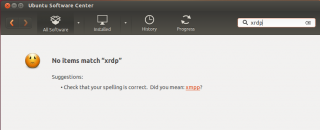
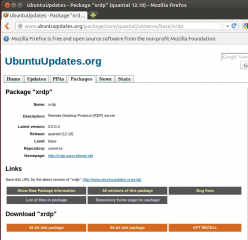
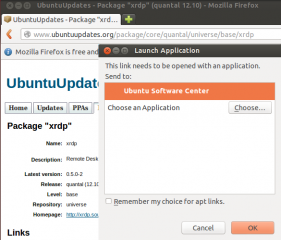
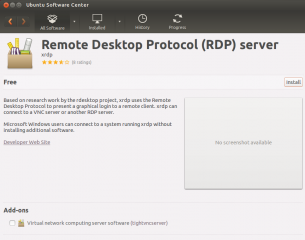
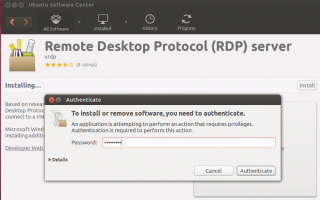
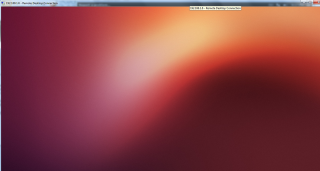

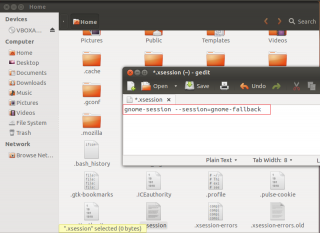
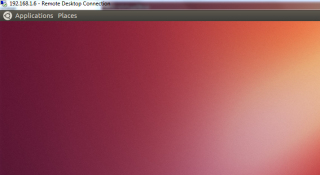

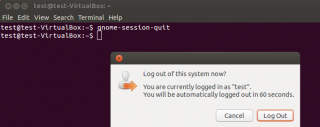
Sir, your tips brought my 2 weeks of research to an end. Thank you!!!
Hello li,
Always a pleasure if a post can be useful
Happy New Year 2013
Till next time
see ya
Yes, BEST instructions ever! My old server died, switched to Ubuntu, used to use putty/Xmin or XDMCP to get my desktop. XDMCP (using lightdm) was PAINFULLY slow and this is SO much better. Not to mention that this (once setup) would be easy for anyone to use! Thanks for the great instructions, helped me through the rest of the setup without having to go sit in the basement.
Thank you, worked perfectly on a Ubuntu 12.10 Desktop vanilla install. An added bonus is that Gnome’s panels are so much nicer than Unity’s HUD. (Yet another reason why Unity was a big mistake, but that’s a rant for another day.) Anyway, bookmarked.
Awesome ! works but my just show part of my desktop ? why ?
Hello Charlie,
I do not know… might be your screen resolution settings that make it showing on a part.. on windows mstsc client ; you have the button options, from there you can specify the screen resolution you want to use.
You might need to edit the sesman.in file (if the problem is on your linux box) and specify some screen resolutions parameters
Hope this help
Till next time
See ya
Please make a note that correct command for .xsession file is:
gnome-session –session=gnome-fallback
with two dashes.
Hello,
Actually, in my post, there are two dashes but the rendering of the page collapsing the dashes and thus showing only.
I’ll try to come up with something to fix it
thank for the remark
Till next time
I tried the steps above but on connecting I get the error:
Failed to load session “gnome-fallback”
with “Logout” button.
Is anyone else seeing this?
Argh, posted the earlier comment in the wrong post so hopefully the host will fix it.. 🙂
Sorry for being dense, didn’t realize that the fallback session needed to be installed.
RDP (and NoMachine NX Client) is working on ubuntu 12.10, with known limitations, after running the below:
$ sudo apt-get install gnome-session-fallback
RDP seems to be less buggy than the nomachine client at first glance.
Sorry for being dense, didn’t realize that the fallback session needed to be installed.
RDP (and NoMachine NX Client) is working, with known limitations, after running the the below:
$ sudo apt-get install gnome-session-fallback
RDP seems to be much more functional than the nomachine client at first glance.
Hello Vishal;
As described in the post; you have to install the gnome-fallback package (see step 2 )
I see from your other comments that you’ve fixed your own issues
Till next time
See ya
Thanx a lot for your post, it was very helpful but unfortunately both RDP and NoMachine are absolutely useless on 12.10 for remoting purposes from Windows (server 2008 R2 in my case). The issues are too many to enumerate. I can barely use the terminal, far less Eclipse.
Thanks a million for these clear instructions. If only everyone was as helpful and caring……
THank you for the visit and the comment….
wish i could to more but not much time available
See ya
Thanks for the workaround! I was really confused why unity wasn’t showing up in my xrdp session.
No Problem
Always happy to help out
Till next time
See ya
Many thanks for this information.
When I try to install xrdp in Ubuntu 12.10. and I’m facing the same problem, just like your notification.
Thank you again.
Thanks! =)
Helo Oskar,
Thank you for your visit and the comment you left
till next time
see ya
Thanks for the excellent guide. Keep up the good work!
Thank you so very much for this guide. I never would have been able to get connect via RDP without it. One suggestion that may help others. Add the bit about “or you can use a command line to perform exactly the same operation” along with the screen cap as you did for Ubuntu 12.04 guide. I had to run everything from a terminal and couldn’t have done it without that step.
I can not find the .Xsession I followed the instruction Ctrl + H. Only two files I only see Xsession-error and Xsession-error.old …. Where can I find this .Xsession? I need help! thnks!
Hello Enzoe, if you do not see the file, you will have to create it. You should read more carefully the post.
the command line (see picture at http://c-nergy.be/blog/wp-content/gallery/xrdp/xrdp_4a.png )can be used to create the file.
Hope this help
till next time
See ya
Thanks Griffon. This blog saves me a lot of time.
But it serves me not.
I want to use this to access a virtual machine, but I require to keep the session alive (and apps running) after I disconnect and be able to reconnect to the same session later on.
Each time you reconnect using xRDP a new session is open.
enzoe:
You can just create the file. I had to create mine as well. From a terminal, type:
touch ~/.xsession
Then you can modify it. This is what i had to do to fix my issue.
Hello there,
If you want to reconnect to your session and see the running applications, you should have a look at the following link http://c-nergy.be/blog/?p=3546 (How to customize xrdp install & login screen on Ubuntu 12.10 – Part I) In this post, we have replaced the tightvnc part with the XVNC component. This configuration should allow you to reconnect to the same active xrdp session.
Part I explains how to perform a manual installation Part II explains how to use a script to perform the custom installation (Part II can be found at http://c-nergy.be/blog/?p=3541)
Give it a try and let me know if this fits your needs
Hope this help
Till next time
See ya
thanks very much ……
i want advice that ..which user you want to connect remotely also copy the “.xsession” file there.
Hello Ankuj,
Good remark indeed, the .xsession file has to be created for each users that will need to access ubuntu via xrdp
Till next time
See ya
Griffon,
You are a saviour. Tried it out with 13.04 and worked fine
Hello Naveen,
Thank for visiting us and for your comments.
I’m happy to see that this info is useful and that people can take advantage of it
till next time
See ya
I’m having a problem with gnome-fallback in an Ubuntu 12.04 server. When I xrdp into the system, the desktop, menus, etc. all appear correctly. But when I click on a pull down menu, the menu appears only so long as I hold down the mouse key. I can scroll down to the item I want, and then release the mouse key which activates that program.
Is there a way to left click on the menu, and NOT have it disappear when I release the click? In other words, the menu stays open, then I can move the mouse cursor down the list without holding the click.
This is a minor annoyance, but I’m trying to set up this server at a K-8 school, and I want the operation to be consistent when logging in locally and remotely.
Thanks for any help!!
Richard
Hello Richard,
If I understand correctly, when you click on the menu and sub menus of the gnome-faillback bar, you are having this issue with display the items in submenus as soon as you release the mouse key. We are talking about the Gnome-fallback menu (and not a pull down menu you would find on a web page)
I have performed a custom xrdp installation by following this guide http://c-nergy.be/blog/?p=3546 and I do not have this issue
Give it a try and let us know if this solve your problem
Till next time
See ya
Griffon, Thanks a lot for your clear descriptions.
But I encounter a problem that the remote desktop connection in my win7 system can’t execute the ‘sudo’ command.
Hello There,
question unclear…..
Where are you trying to perform the sudo command ? on windows 7 or ubuntu. Win7 does not know about sudo…
What are you trying to do with Sudo ?
If you provide a little bit more background info I might be able to help
Till next time
see ya
Iǘe installed Ubuntu 13.10 and xrdp don work anymore, Iĺl get from my windows7 machine only a black-white screen, after the login…..
Hello There,
Please review the following link http://c-nergy.be/blog/?p=4448. This explain how to use xrdp software with Ubunt 13.10. The gnome-fallback session is not working anymore in ubuntu 13.10
Hope this help
Till Next Time
See ya
I truly appreciate this article.Really thank you! Fantastic. aekkddeddefeacfa